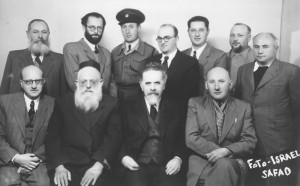Zefat (Safed), is located in the mountains of the Upper Galilee in the North of Israel, 900 meters (2952 ft), above sea level. Zefat commands magnificent views: the Golan Heights in the east, Mt. Hermon and Lebanon in the north, Mt. Meron in the west and Tiberias & the Kinneret (sea of Galilee) in the south.
Zefat is one of the 4 holy cities, together with Jerusalem, Hebron and Tiberias. Zefat was founded in 70 C.E. and is referred to as Tzefiya in the Talmud. Yossef Ben Mattityahu (Josephus Flavius) who was commander of the North of Israel during the revolt against the Romans, fortified Zefat before he became a turncoat.
The crusaders turned it into an administrative center, building one of the largest Frankish castles in the Middle East. It was besieged by Saladin in 1188.
When Sultan Beibars finally took it in 1266, he decapitated the men and sold the women and children into slavery. As the Crusader cities along the coast fell to the Mamelukes, many Jews moved to Zefat. The town prospered and was the capital of a province and a lively commercial centre. Zefat took in many Jews following their expulsion from Spain in 1492. During the 16th century it positively shone with learning.
The rabbis and the sages were all attracted by the proximity of the tomb of Rabbi Shimon Bar-Yochai at Meron. He was the author of the “Zohar” ( Book of Splendor), which was the basic book of the Kabbalists. It is a mystical commentary on the Five Books of Moses and proceeds from the premise that every letter, word and line in the scriptures is significant, containing a higher mystical meaning and offering the key to life.
Famous Rabbis lived in Zefat. The great Kabbalist, Rabbi Yitzhak Luria, (Ha’Ari) (1534-1572) whose Lurianic Kabbala was influential in the development of modern Hassidic movement; Yoseph Caro (1536-1575), who wrote the “Shulhan Arukh” (Code of Jewish Law); Rabbi Chaim Vital (1543-1620) who was Ha’Ari’s main disciple and recorded his teachings in the book Etz Chaim (tree of Life); Rabbi Shlomo Al-Kabetz (1508-1593), Author of the famous liturgical poem “Lecha Dodi”, sung by Jews worldwide to welcome the Shabbat; Rabbi Moshe Al-Sheich (1508-1593), Kabbalist, student of Yosef Caro and member of his Beit Din; Rabbi Moshe Kordovero (1522-1570) known by the acronym of his name, Ramak, considered the head of the Zefat Kabbalists until his death shortly after the arrival of Rabbi Yitzchak Luria. Author of Pardes Rimonim (“Orchard of Pomegranates”); Israel Najara (1555-1628) whose poems have become part of the Sephardi synagogue ritual.
In 1563 the first Hebrew printing press in Eretz Yisrael was established in Zefat. Its books were in much demand word wide.
A breakdown in law and order along the Galilee highways, together with a plague in 1742 and an earthquake in 1759, account for Zefat’s decline. However, the Jewish population increased somewhat with the arrival of some Russian Hassidim in 1776. Napoleon’s troops were garrisoned at Zefat to secure the highway to Damascus. The Crusader castle was completely destroyed in the earthquake that shook the town in 1837, and many of the loosened stones were used in building houses in the city including the house built by Rabbi Yona Podhorzer.
From the middle of the 19th century to the middle of the 20th century, the Pedhatzur and Silberman families became prominent in city affairs. Rabbi Rephael (Raful) Silberman was appointed Chief Rabbi of the City (1859). His sons and grandsons became very active in the discovery of burial places of sages in the North of Israel. His daughter Rochama married Elazar Yacov Podhorzer who was very active in city affairs. He purchased the land in Mt. Meron and established a Yeshiva there. Their son, Moshe Pedhatzur assumed the leadership of the Jewish community in Zefat during the late 1920s and in 1948 became the first mayor of the city. (That year upon the establishment of the state of Israel, Moshe and his descendants Hebraicized their name from Podhorzer to Pedhatzur). His first cousin, Rabbi Avraham Leib Silberman became the chief rabbi of Zefat when Raful Silberman died. Rabbi Avraham Leib Silberman died few months before Zefat was liberated. His son-in-law, Rabbi Kaplan, succeeded him as Chief Rabbi of Zefat.
During the Arab pogroms of 1929 and 1936 and also during the war of independence in 1948, the British tried to evacuate the Jewish population for “security” reasons but Moshe Pedhatzur who was the head of the Jewish Community refused, thus ensuring that Zefat remained a Jewish stronghold in the Galilee and was later included in the map of the young state.
When the British left Zefat in 1948, they gave the Arabs all the key strategic positions in the city and around it on Mt. Canaan. The Jews were poorly armed and had one small canon called Davidka. When it was fired, it made more noise than damage, but following that the Arabs fled the city in great panic. It was later discovered that they were told the Jews had an Atomic bomb. It would be easy to recognize when the Jews would use it, How? It would make a huge sound and after that it will rain heavily, This is exactly what happened when the Davidka was fired…
Zefat became an Israeli city. Moshe Pedhatzur was its first mayor. One of his major achievements in the new city was to build the Artist’s colony.


